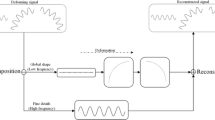Abstract
A large number of applications in medical visualization, games, engineering design, entertainment, heritage, e-commerce and so on require the transmission of 3D models over the Internet or over local networks. 3D data compression is an important requirement for fast data storage, access and transmission within bandwidth limitations. The Wavefront OBJ (object) file format is commonly used to share models due to its clear simple design. Normally each OBJ file contains a large amount of data (e.g. vertices and triangulated faces, normals, texture coordinates and other parameters) describing the mesh surface. In this paper we introduce a new method to compress geometry, connectivity and texture coordinates by a novel Geometry Minimization Algorithm (GM-Algorithm) in connection with arithmetic coding. First, each vertex (x, y, z) coordinates are encoded to a single value by the GM-Algorithm. Second, triangle faces are encoded by computing the differences between two adjacent vertex locations, which are compressed by arithmetic coding together with texture coordinates. We demonstrate the method on large data sets achieving compression ratios between 87 and 99 % without reduction in the number of reconstructed vertices and triangle faces. The decompression step is based on a Parallel Fast Matching Search Algorithm (Parallel-FMS) to recover the structure of the 3D mesh. A comparative analysis of compression ratios is provided with a number of commonly used 3D file formats such as VRML, OpenCTM and STL highlighting the performance and effectiveness of the proposed method.
Graphical Abstract
















Similar content being viewed by others
References
Alliez, P. & Gotsman, C. (2003). Recent advances in compression of 3D meshes. Inria Sophia Antipolis Research Report 4966, Oct 2003 pp. 26
DCT (2012). 3D compression technologies (3DCT), www.3dcompress.com/web/default.asp. Accessed Oct 2012.
Deering, M. (1995). Geometry compression. In SIGGRAPH 95 Proceedings of the 22nd Annual Conference on Computer Graphics and Interactive Techniques.
Deering, M. (1995). Geometry compression. In Computer Graphics (SIGGRAPH’95 Proceedings), pp. 13–20.
Donald, K. (1997). Sorting and searching: section 6.2.1: searching an ordered table, the art of computer programming. (3rd Ed.), Addison-Wesley. pp. 409–426. ISBN 0-201-89685-0.
Evans, F., Skiena, S.S., & Varshney, A. (1996). Optimizing triangle strips for fast rendering. In IEEE visualization. IEEE, October 1996. ISBN 0-89791-864-9.
Gurung, T., Luffel, M., Lindstrom, P., & Rossignac, J. (2013). Zipper: A compact connectivity data structure for triangle meshes. Journal of Computer –Aided Design, 45(2), 262–269.
Hollinger, S.Q., Williams A.B., & Manak, D. (1998). 3D data compression of hyper spectral imagery using vector quantization with NDVI-based multiple codebooks, IEEE International Geosciences and Remote Sensing Symposium IGARSS’98, Vol. 5, 2680–2684.
Murdock, K. L. (2008). 3DS max 2008 Bible (1st ed.). Indianapolis, Indiana: Wiley Publishing, Inc. ISBN 9780470417584.
Neider, J., Davis, T., & Woo M. (1997). OpenGL programming guide—The official guide to learning openGL, Version 1.1. Addison-Wesley, Reading, MA, USA.
Peng, J., Kim, C. S., & Kuo, C. C. (2005). Technologies for 3D mesh compression: A survey. Journal of Visual Communication and Image Representation, 16(6), 688–733.
Richardson, I. E. G. (2002). Video codec design. USA: Wiley.
Rodrigues, M., Kormann, M., Schuhler, C., & Tomek, P. (2013b) Robot trajectory planning using OLP and structured light 3D machine vision. Lecture notes in Computer Science Part II. LCNS Springer, Heidelberg, Vol. 8034, pp.244–253
Rodrigues, M., Kormann, M., Schuhler C., & Tomek, P. (2013c). Structured light techniques for 3D surface reconstruction in robotic tasks.In Proceedings of the 8th International Conference on Computer Recognition Systems CORES 2013, Springer, pp. 805–814.
Rodrigues, M., Kormann, M., Schuhler C., & Tomek, P. (2013d). An intelligent real time 3D vision system for robotic welding tasks. In: Mechatronics and its applications. IEEE Xplore, pp. 1–6.
Rodrigues, M., Osman, A., & Robinson, A. (2011). Efficient 3D data compression through parameterization of free-form surface patches. In: Signal Process and Multimedia Applications (SIGMAP), Proceedings of the (2010) International Conference on. IEEE, 130–135.
Rodrigues, M., Osman, A., & Robinson, A. (2013). Partial differential equations for 3D data compression and reconstruction. Journal Advances in Dynamical Systems and Applications, 8(2), 303–315.
Rossignac, J. (2003). 3D mesh compression. College of Computing and GVU Center Georgia institute of Technology Report, June 2003 Chapter Five-Visualization HandBook.
Sayood, K. (2000). Introduction to Data Compression (2nd ed.). USA: Academic Press, Morgan Kaufman Publishers.
Shikhare, D., Babji, S.V., & Mudur, S.P. (2002). Compression techniques for distributed use of 3D data: an emerging media type on the internet. In 15th International Conference on Computer Communication, India, pp. 676–696.
Siddeq, M. M., & Rodrigues, M. E. (2014). A novel image compression algorithm for high resolution 3D reconstruction, 3D Research. Springer,5 (2). Doi:10.1007/s13319-014-0007-6.
Szymczak, A., King, D., & Rossignac, J. (2000). An edgebreaker-based efficient compression scheme for regular meshes. In 12th Canadian Conference on Computational Geometry, pp. 257–265.
Taubin, G., Horn, W., Lazarus, F., Rossignac, J. (1998). Geometry coding and VRML, Proceedings of The IEEE, 86(6).
Taubin, G., & Rossignac, J. (1996). Geometric compression through topological surgery. Technical report, Yorktown Heights, NY 10598, Jan 1996. IBM Research Report RC 20340.
Taubin, G., & Rossignac, J. (1998). Geometric compression through topological surgery. ACM Transactions on Graphics, 17(2), 84–115.
Author information
Authors and Affiliations
Corresponding author
Rights and permissions
About this article
Cite this article
Siddeq, M.M., Rodrigues, M.A. Novel 3D Compression Methods for Geometry, Connectivity and Texture. 3D Res 7, 13 (2016). https://doi.org/10.1007/s13319-016-0091-x
Received:
Revised:
Accepted:
Published:
DOI: https://doi.org/10.1007/s13319-016-0091-x




